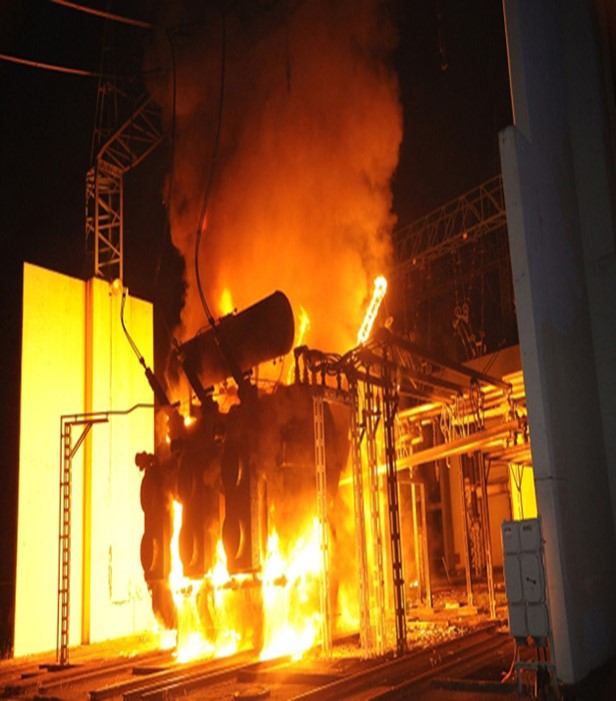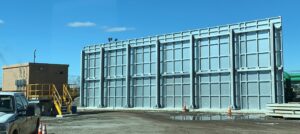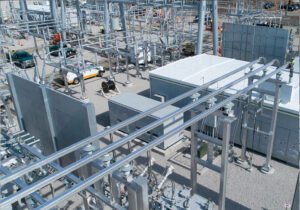The likelihood of a transformer exploding and then burning is quite low; however, it’s not impossible. And that’s because the firewall barriers installed on transformers are highly efficient in reducing the likelihood of explosions and fires. However, there are cases where transformers blow and burn. In most of these cases, the transformer explosions and burns often result in injuries, deaths, property damage, and electric failure that could last for weeks.
What Causes a Transformer to Blow?
A transformer can blow for several reasons, but the most common ones fall into three categories: electrical failures, mechanical issues, and environmental factors.
1. Electrical Failures
- Overloading – When a transformer has to handle more electricity than it’s built for, it overheats. Over time, this weakens its parts and can lead to a breakdown.
- Short Circuits – If something inside or outside the transformer causes a short circuit, it can send a sudden surge of electricity through the system, damaging the transformer.
- Power Surges – Lightning strikes, switching errors, or sudden changes in voltage can overwhelm a transformer and cause it to fail.
2. Mechanical Issues
- Loose or Worn-Out Parts – If a transformer isn’t maintained properly, bolts, wires, and connections can wear out or come loose, leading to internal damage.
- Manufacturing Defects – A poorly built transformer may have weak insulation or bad wiring, making it more likely to fail under stress.
3. Environmental Factors
- Storms – Lightning, strong winds, and falling trees can damage transformers or their power lines.
- Extreme Temperatures – Very hot weather can cause overheating, while extreme cold can make insulation brittle and prone to cracking.
- Flooding – If water gets inside a transformer, it can cause electrical shorts and lead to an explosion.
All these issues can weaken a transformer over time. If not caught early, they can lead to a dangerous failure.
Why Do Transformers Blow?
Transformers blow due to internal failures, most commonly caused by short circuits. These faults often occur when insulation breaks down, causing high heat. The resulting pressure buildup, along with temperatures reaching over 1,200°C, leads to an explosion and fire risk.
When a transformer blows, it’s usually because something inside has gone wrong. The main reason is heat and pressure buildup. Here’s what happens:
- Insulation Breakdown – Transformers use special insulation to keep electrical parts separate. If this insulation wears out or gets damaged, electricity can jump to places it shouldn’t, creating a short circuit.
- Extreme Heat – Short circuits and overloading create intense heat inside the transformer. If the temperature gets too high, the oil inside the transformer (which helps cool it down) starts to break apart.
- Gas Formation – When the oil heats up too much, it turns into gas. This gas builds up fast, creating pressure inside the transformer tank.
- Pressure Explosion – Transformers aren’t designed to handle extreme pressure. When the gas pressure gets too high, the metal tank can burst open. This is what causes the loud explosion people hear when a transformer blows.
Most transformers have built-in safety features to prevent explosions, but if the failure happens too quickly, there’s often no time for these protections to stop it.
How Does a Transformer Blow?
A transformer doesn’t just explode out of nowhere—it follows a chain reaction. Here’s a step-by-step breakdown of what happens when a transformer blows:
Step 1: A Problem Starts
- A power surge, short circuit, or mechanical failure happens inside the transformer.
- This creates extra heat, weakening insulation and internal parts.
Step 2: The Heat Builds Up
- The heat causes the insulating oil to break down, forming gas bubbles.
- These gas bubbles expand, increasing pressure inside the metal tank.
Step 3: The Pressure Gets Too High
- If the pressure builds too quickly, the transformer’s safety valves may not be able to release it fast enough.
- The metal casing starts to bend and weaken.
Step 4: The Explosion Happens
- The tank bursts open, releasing the built-up gas and heat.
- The explosion is often followed by fire, as the oil inside the transformer ignites when it contacts oxygen.
- Sometimes, debris from the transformer flies outward, creating more damage.
Step 5: The Aftermath
- The area around the transformer might experience power loss.
- Firefighters and utility workers must assess the damage and shut down power if needed.
This whole process happens fast—often in just a few seconds. That’s why transformer explosions can be so sudden and dangerous.
What Happens When a Transformer Blows?
When a transformer blows, the effects are immediate and serious. The explosion is often loud, followed by visible flashes of light, fire, or smoke. Here’s what can happen next:
1. Power Outages
- A blown transformer can cut off electricity to homes, businesses, and entire neighborhoods.
- Depending on the damage, power can be out for a few hours or even days.
- In some cases, backup systems keep the lights on, but these only work for a limited time.
2. Fire Risks
- Many transformers contain oil that helps cool them down. If this oil heats up too much, it can ignite.
- A transformer fire can spread quickly, especially if it’s near trees, buildings, or power lines.
- Firefighters must be called immediately to control the flames and prevent further damage.
3. Electrical Hazards
- Downed power lines are one of the biggest dangers after a transformer blows.
- If wires fall to the ground, they can still be live and extremely dangerous to touch.
- Sparks and electrical arcs from a failed transformer can also start fires or damage nearby electronics.
4. Noise and Physical Damage
- The explosion itself can sound like a gunshot or a loud boom, startling people nearby.
- If the transformer bursts apart, pieces of metal and other debris may scatter, causing additional hazards.
5. Emergency Response
- Power companies, firefighters, and repair crews are usually dispatched immediately to secure the area.
- Residents should stay away from the site and report the incident to the electric company.
- If traffic signals are out due to a power failure, drivers should treat intersections as four-way stops to avoid accidents.
A blown transformer isn’t just a power problem—it’s a potential fire and safety hazard. That’s why it’s important to report the issue quickly and avoid the area until professionals handle it.
Why Do Transformers Blow During Storms?
Storms are one of the biggest reasons transformers fail. Here’s how different weather conditions can lead to a transformer blowing:
1. Lightning Strikes
- When lightning hits a power line or directly strikes a transformer, the sudden surge of electricity can overwhelm the system.
- Transformers have built-in lightning protection, but a direct hit can still cause severe damage.
- Even if the transformer doesn’t explode immediately, the extra voltage can weaken its insulation, leading to failure later.
2. Strong Winds and Falling Trees
- High winds can knock over power poles, snapping electrical lines and damaging transformers in the process.
- Trees and branches that fall onto power lines can create short circuits, sending dangerous bursts of electricity through the system.
3. Heavy Rain and Flooding
- Water and electricity don’t mix. If water seeps into a transformer, it can cause electrical shorts and internal damage.
- Flooded transformers may stop working immediately, or they might fail later due to moisture buildup inside.
4. Power Surges During Storms
- When electricity supply is disrupted—like when a tree knocks down a power line—the system can experience rapid voltage changes.
- These fluctuations put extra stress on transformers, increasing the risk of failure.
- If power is restored suddenly after an outage, a voltage spike can occur, damaging already weakened transformers.
Because storms affect entire power grids, a single transformer failure can lead to widespread blackouts. Utility companies work hard to reinforce transformers and power lines, but extreme weather can still cause major disruptions.
Can a Blown Transformer Cause a Power Surge?
Yes, a blown transformer can cause a power surge, but it depends on how the failure happens.
1. Direct Surges from the Explosion
- When a transformer fails, it can release a sudden burst of energy into nearby power lines.
- This energy spike can damage electronics plugged into the grid, especially if there’s no surge protection.
- If the transformer explodes due to an internal short circuit, it can send irregular voltage waves through the system.
2. Surges from Power Reconnection
- After a transformer blows, the power company works to restore electricity by rerouting power through other transformers.
- When power is restored, the sudden return of electricity can cause a brief surge, which may damage appliances if they aren’t protected.
3. Protection Against Surges
- Surge protectors help shield electronics from sudden voltage spikes.
- Utility companies use circuit breakers and relays to minimize damage when transformers fail.
- During storms or outages, unplugging sensitive electronics (like computers and TVs) can help prevent damage from unexpected surges.
While not every blown transformer causes a surge, it’s always smart to be cautious and use surge protectors to avoid potential damage.
Transformer Blew But Still Have Power – Is That Possible?
Yes, it’s possible for a transformer to blow, but power remains on in some areas. This happens because of how the power grid is designed. Here’s why:
1. Multiple Transformers Serving the Same Area
- In many neighborhoods, power doesn’t come from just one transformer.
- If one transformer blows, other transformers nearby might still be supplying power to the area.
- This is more common in cities, where power grids are designed with overlapping coverage to prevent total blackouts.
2. Backup Power Systems
- Some buildings, businesses, and hospitals have backup generators that automatically turn on when a transformer fails.
- Certain areas may also have battery backup systems that provide short-term power until the main supply is restored.
3. Grid Switching
- Power companies can reroute electricity through different transformers and substations.
- If a transformer blows, the grid may automatically adjust and send power through another source to keep lights on.
4. Partial Transformer Failure
- Not all transformer failures result in an explosion or total shutdown.
- If only part of the transformer is damaged, it might still supply some power but at a lower or unstable voltage.
- This can cause lights to flicker or appliances to work improperly.
Even if power stays on after a transformer blows, the situation should still be reported. A damaged transformer can cause future outages, voltage issues, or fire risks, so it needs to be checked by utility workers.
How to Tell If a Transformer Blew?
A transformer failure isn’t always obvious at first, but there are key signs to watch for:
1. Loud Noise
- A blown transformer often makes a loud bang or boom.
- Some people describe it as sounding like a gunshot or an explosion.
- If you hear a sudden, unusual noise near a power pole, it might be a transformer failure.
2. Flickering or Loss of Power
- If lights flicker, dim, or go out completely, a transformer might have blown.
- Sometimes power goes out in only part of a building or neighborhood, depending on how electricity is distributed.
3. Smoke or Fire
- A damaged transformer can overheat and catch fire.
- Smoke or flames near a power pole or utility box could be a sign of a failure.
4. Visible Damage
- If you see a transformer that looks burned, leaking, or broken open, it’s likely blown.
- Pieces of metal or debris around the transformer are also signs of an explosion.
5. Buzzing or Humming Before Failure
- Transformers normally make a low humming sound, but if it gets louder or irregular, it might be struggling.
- A transformer that’s overheating or short-circuiting might buzz, crackle, or pop before it blows.
6. Power Surges or Electrical Issues
- A failing transformer may send unstable power through the grid, causing:
- Lights to flicker or become dim
- Appliances to reset or act strangely
- Sudden power surges that could damage electronics
If you notice any of these signs, it’s best to stay away from the area and report the issue to the power company.
What Does It Mean When a Transformer Blows?
A blown transformer can mean different things depending on the situation, but it usually signals a problem somewhere in the electrical system.
1. Power Disruptions
- A transformer explosion often leads to partial or full power outages in nearby homes and businesses.
- Depending on how the power grid is set up, outages could last minutes, hours, or even days if repairs take longer.
2. Electrical Safety Concerns
- A failed transformer can leave behind live power lines or damaged electrical equipment.
- If lines are down, people should stay away to avoid electrocution.
3. Grid System Stress
- If multiple transformers fail at once—especially during storms or heat waves—it can overload the grid and cause widespread outages.
- Utility companies may need to reroute power or reduce supply to prevent bigger failures.
4. Repair and Replacement Costs
- Fixing a blown transformer isn’t instant. Power companies need to:
- Assess the damage
- Shut down power safely
- Replace or repair the transformer
- Restore electricity to affected areas
- In severe cases, replacing a transformer could take hours or days, especially if special equipment is needed.
5. Risk of Fire or Further Damage
- If a blown transformer sparks a fire, it can spread to nearby buildings, trees, or power lines.
- Even if there’s no fire, electrical damage from a transformer failure can affect other parts of the grid.
In short, when a transformer blows, it’s more than just a loud noise—it’s a signal that something went wrong in the power system, and it needs to be fixed quickly to prevent bigger problems.
How Loud Is a Transformer Explosion?
A transformer explosion can be very loud, often startling people nearby. The exact noise level depends on a few factors, but in most cases, it’s loud enough to be heard from a considerable distance.
1. Typical Noise Level
- A transformer explosion can reach around 140 to 160 decibels (dB)—comparable to:
- A gunshot (140–150 dB)
- A jet engine at takeoff (150 dB)
- A firecracker explosion (140–160 dB)
- At close range, this can cause temporary hearing loss or ringing in the ears.
- From farther away, it might sound more like a distant thunderclap or a heavy object crashing.
2. Factors That Affect the Loudness
- Size of the Transformer – Larger transformers handle more electricity and contain more cooling oil, leading to bigger, louder explosions.
- Cause of the Failure – If a transformer bursts due to high-pressure buildup, the explosion is much louder than a slow-burning failure.
- Location – If the transformer is in an open area, the sound spreads more. In city environments, buildings can reflect the sound, making it seem even louder.
- Distance from the Transformer – Close by, the sound is sharp and intense. A few blocks away, it may just sound like a distant boom.
Some people mistake transformer explosions for fireworks, thunder, or even an earthquake due to the sudden, powerful shockwave.
What Does It Sound Like When a Transformer Blows?
The sound of a transformer failure varies depending on how it happens. Some failures start quietly, while others explode instantly. Here’s a breakdown of different failure sounds:
1. Electrical Buzzing or Humming (Before Failure)
- Normally, transformers hum softly due to the electricity flowing inside.
- If a transformer is struggling or overheating, this hum can get louder or irregular.
- A failing transformer may also make a crackling or sizzling noise before it blows.
2. Popping or Sparking Sounds
- If a transformer develops small internal failures, it may start popping, clicking, or arcing.
- This can sound like a campfire crackling or a sparkler fizzing.
- Sometimes, the failure stops here, but in other cases, it builds up to a full explosion.
3. A Loud Bang or Boom (Full Explosion)
- If a transformer completely blows, it usually produces a massive, single boom.
- It’s often described as:
- A gunshot or firecracker going off
- A car backfiring
- A distant explosion
- The shockwave from the blast can rattle windows and set off car alarms.
4. Hissing or Sizzling (After the Blast)
- If the explosion damages electrical wires, you might hear a loud hissing sound as electricity arcs.
- This can be followed by a low rumble as the transformer burns out or releases pressure.
A transformer failure can go quietly or violently, but in most cases, there’s at least some warning before a full explosion happens.
Does a Transformer Blowing Sound Like a Gunshot?
Yes, in many cases, a transformer explosion does sound like a gunshot—but there are some key differences.
Similarities to a Gunshot:
- Both are loud, sudden, and sharp.
- Both can echo through streets, making it hard to tell where the sound came from.
- Both can cause alarm, especially if people aren’t sure what they just heard.
Differences from a Gunshot:
- Transformers often have a deeper, more echoing boom. A gunshot is usually a short, sharp crack, while a transformer explosion has more of a rumbling effect.
- Transformer explosions may come with flashes of light. Gunshots don’t produce a visible spark or glow.
- A blown transformer can shake the ground slightly. Large transformers can create a shockwave strong enough to rattle windows.
How to Tell the Difference in Real Life:
- If the sound is followed by power flickering or going out, it’s likely a transformer.
- If you see a bright flash near a power pole, it’s almost certainly a transformer.
- If the sound is isolated and doesn’t cause other electrical issues, it’s more likely to be a gunshot or another loud noise.
Many people report hearing multiple “gunshots” in a row when a transformer explodes. This happens because pieces of the transformer break apart and create smaller bursts of energy.
If you hear a loud explosion and aren’t sure what it was, check for power outages or flickering lights. If something seems wrong, call the power company to report it.
What to Do If a Transformer Blows?
A blown transformer can be dangerous, so it’s important to act quickly and stay safe. Here’s what you should do step by step:
1. Stay Away from the Transformer
- If you hear a loud boom or see a flash of light, do not approach the transformer.
- Blown transformers can cause downed power lines, fires, and electrical shocks.
- Keep at least 30 feet (10 meters) away—electricity can still travel through the ground or metal objects nearby.
2. Look for Signs of Danger
- Sparks or flames – This means the transformer is actively burning and could cause further damage.
- Hissing or buzzing sounds – This could mean power is still flowing, which is extremely dangerous.
- Smoke or burning smell – The transformer could be overheating, leading to another failure.
- Fallen power lines – Never touch a downed line; even if it looks inactive, it could still be live.
3. Call the Power Company Immediately
- Report the outage or explosion to your local power company.
- Many utility companies have emergency hotlines or online reporting systems.
- Give them details like the location, whether there’s smoke or fire, and if power lines are down.
4. Call Emergency Services if There’s Fire or Danger
- If you see flames or a burning transformer, call 911 or your local fire department.
- Firefighters have the right equipment to put out transformer fires safely.
5. Avoid Using Electrical Appliances
- If the power flickers or goes out, unplug sensitive electronics like TVs, computers, and refrigerators.
- When power is restored, there may be a surge that could damage your devices.
6. Check for Local Power Outages
- Sometimes, power companies provide updates online or through automated phone systems.
- If you live in an apartment or shared building, check if your neighbors also lost power.
7. Use Flashlights, Not Candles
- If the outage lasts a while, use flashlights or battery-powered lanterns instead of candles.
- Open flames can be a fire hazard, especially during emergency situations.
8. Wait for Power to Be Restored
- Power companies usually prioritize restoring power in stages.
- If a transformer needs replacement, it could take hours or even days, depending on the damage.
- Stay informed by checking power company updates.
9. Stay Inside If Possible
- A blown transformer can cause traffic signal failures, making roads dangerous.
- If it happened during a storm, additional outages or surges might follow.
10. Report Any Unusual Electrical Issues After Power is Back
- If lights flicker, outlets spark, or appliances behave strangely after power is restored, report it to the utility company.
- There might still be damage in the electrical system that needs fixing.
Important: Never try to fix or touch a transformer yourself. Only power company workers and emergency responders should handle it.
How Often Do Transformers Explode?
Transformer explosions aren’t extremely common, but they do happen. The frequency depends on weather conditions, maintenance, and system load. Here’s what we know:
1. General Frequency of Transformer Explosions
- The U.S. alone has about 2,000 transformer explosions each year.
- Power grid failures (including transformer failures) cause over 3,000 power outages annually.
- Most failures are minor and don’t lead to full explosions, but severe cases can be destructive.
2. When and Where Transformer Explosions Happen Most
- During storms – Lightning, wind, and flooding are the biggest reasons transformers fail.
- In extreme heat or cold – High temperatures increase the risk of overheating, while freezing conditions can cause insulation damage.
- In older power grids – Transformers in aging infrastructure (some over 40 years old) are more prone to failure.
- In areas with high energy demand – Cities with heavy power use put extra stress on transformers, increasing the risk of breakdowns.
3. How Transformer Explosions Can Be Prevented
- Regular Maintenance – Utility companies check transformers for wear and tear, oil leaks, and overheating.
- Upgrading Old Equipment – Replacing outdated transformers with newer, safer models reduces failure rates.
- Better Insulation and Cooling – Keeping transformers properly insulated and cooled helps prevent breakdowns.
- Lightning Protection – Many transformers now have surge protectors to handle sudden spikes in voltage.
- Smart Grid Technology – Some modern grids detect problems early and reroute power to prevent transformer overload.
4. Can Transformer Explosions Be Completely Avoided?
- Not entirely—transformers handle massive amounts of electricity, and failures can still happen.
- However, routine inspections and advanced technology have reduced major transformer explosions over time.
While transformer failures are not an everyday event, they do happen often enough that power companies are always working to improve safety.
Sinisi Solutions
75 Main St, Manasquan, NJ 08736
732-232-2100




